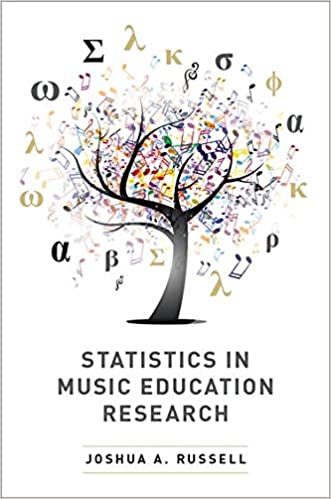Russell, J. Statistics in music education research: A reference for researchers, teachers, and students. Oxford University Press, 2018.
Review by Kate M. Bertelli-Wilinski
Music teacher and researcher in the United States and a recent doctoral graduate of the University of Colorado Boulder, USA.
In comparison to some other fields, there are few research-oriented books written with music educators in mind. New to the scene is Dr. Joshua Russell’s book, Statistics in Music Education Research. The primary goal of this book is to “[advance] the understanding of how parametric statistics are employed and interpreted in the social science field of music education” (p. xvi). Ultimately, Dr. Russell hoped his book would bolster readers’ skills for connecting symbolic reasoning with content and meaning. This book was created specifically for those who are teaching or learning about quantitative research methods, however it is also appropriate for the more experienced researcher. To date, Statistics in Music Education Research is the only quick-reference resource for statistical analyses. Its “how-to” approach makes it both the perfect companion to a comprehensive main course textbook and a one-stop shop for crafting a basic analytical report.
The book is comprised of 23 chapters that are organized into four sections: introduction, parametric statistical procedures, reliability analysis, and nonparametric tests. In the introduction (chapters 1 and 2), Dr. Russell offers the reader a basic overview of some of the core aspects of quantitative research. Particularly, it contains critical information for understanding and interpreting statistical tests. Chapter 1 topics include hypothesis testing, central tendency, data set distributions, variability, error, types of variables and data, types of statistical procedures, significance, and degrees of freedom. Also included in chapter 1 is a table that displays the types of questions associated with each statistical test. Chapter 2 addresses descriptive statistics—what Dr. Russell refers to as the “building blocks” (p. 31) of data analysis. Unlike the earlier writing, chapter 2 foreshadows the structure of future chapters. After a brief explanation about the role of descriptive statistics in music education research, Dr. Russell presents step-by-step guides for running descriptive analyses using SPSS (Statistical Package for the Social Sciences). These guides include “click-this-then-that” software instructions as well as figures of SPSS outputs alongside narrative explanation for interpreting the output. Separate guides are included for different types of data (e.g. continuous vs. categorical). Chapter 2 also contains reporting examples (i.e. an analytical write up) in both narrative and table format.
Following the introductory chapters, each subsequent chapter (numbers 3 to 23) is focused on one specific test. The nature of the test dictates its grouping within the larger section headers. Parametric tests, which are predominant in this text, are presented in chapters 3 to 15—Pearson Product-Moment Correlation, One-Sample T-Test, Dependent-Samples T-Test, Independent Samples T-Test, Univariate Analysis of Variance (ANOVA), Factorial ANOVA, Multivariate ANOVA, Repeated Measures ANOVA, Univariate Analysis of Covariance (ANCOVA), Multivariate ANCOVA, Regression Analysis, Data Reduction, and Discriminant Analysis. Chapters 16 and 17 feature two reliability analyses, Cronbach’s Alpha and Split-Half Reliability. Finally, the following non-parametric tests are covered in chapters 18-22: Chi-Square, Mann-Whitney U, Kruskal Wallis H, Spearman Correlation, Wilcoxon, and Friedman.
Chapter particulars are organized using the same flow, allowing the reader to predict the direction of the chapter. For each test, Dr. Russell explains its purpose, necessary assumptions, and research design, and provides examples of null/alternative hypotheses statements. Like chapter 2, these chapters are inclusive of step-by-step SPSS guide demonstrations. The guide, narrative description, and one of the reporting examples are conveniently based on the same sample story. Another reporting example from a published source is often presented. Some chapters include information that is unique to the featured test, such as mathematical or formulaic notation, or choices for post hoc tests. Additionally, each chapter concludes with a checklist of helpful “writing hints” for data reports and a practice exercise that can be conducted using the companion website data files.
When looking at the information included in this book, some methods instructors may question its exigency as a required course text. Similarly, the more experienced researcher may wonder why this book would be a good addition to their personal collection. True, other research method books contain similar material. Dr. Russell’s book, however, has unique benefits that make it worthy of consideration. For one, the emphasis on statistics is dissimilar to other method books that present a more holistic understanding of quantitative research. By prioritizing symbolic reasoning, Statistics in Music Education Research offers readers a window into deeper understanding of analytical results. For the research student, a deeper understanding may arise from the opportunity to hone in on the underlying mathematical principles of a test rather than learn it amidst other discussions about group designs, number of variables, or types of data. Students can even practice conducting these tests using downloadable data sets (Excel files) on the companion site.
Another benefit to the book is its overall organization. The concise one-test per chapter and organizational section groupings make it easier for the reader to draw connections between the types of tests that exist (i.e. the ways in which they are similar and different), and why each one is exclusively bound to the nature of a research question. Moreover, the convenient format offers immediate step-by-step assistance when conducting and writing up a statistical report. Beyond the order in which information is presented, the means of explanation is also highly desirable. It is evident that Dr. Russell wields a skill for writing seemingly abstract details clearly and effectively. Additionally, the conversational approach—where questions are both asked then answered—helps keep the reader engaged. Here is a prime example of such a rhetorical exchange:
“SPSS will create the exact same readout as you received the first time you conducted your analysis. You may ask, then, why not just do it when you first run your analysis? The answers are that you may not need to do a post hoc test at all if you find that there is not significance found overall, and you will not know if you can assume equal variance until you complete the Levene test. Therefore, you would not know what type of post hoc test to complete. Why make your first step into your analysis more complicated by creating extra readouts you may not need?” (p. 107).
During my doctoral studies I would often read Dr. Russell’s bookbefore other assigned course readings because of its approachability and adequate attention to detail. Additionally, reading about music education in the descriptions made the concepts even more relatable. Post coursework, this book continues to be one of my most favorite and frequently used resources.
Statistics in Music Education Research is quite thorough for its first edition. As with any first edition, however, there is room for enhancement. Beyond the inconsequential spelling or typographical error, there are a few opportunities for the author to clarify and expand on some ideas. Personally, I found myself re-reading instances where formulas were presented. I also thought that the explanations for degrees of freedom and Tukey’s test of additivity were limited. For those newer to research or statistics, these are abstract ideas that could use a little more attention. Another issue that contributed to ambiguity was the book’s page size and formatting—for example, SPSS outputs are often on different pages than the write up or table and the reader has to toggle between pages to read the explanation. In these instances, tracking can be more difficult. Readers might also have understood concepts better and faster if the book featured one context-based example (and accompanying dataset) throughout the explanations. Such an approach could emphasize the fact that statistical tests are reliant on the research questions, and that research studies can (and often do) employ more than one test at a time. Despite these critiques, I still uphold my opinion that the text is predominantly well structured and written in a fluid and comprehensible manner.
The only real limitation to this book is that it caters to researchers who use SPSS. While SPSS has been industry standard, The R Project for Statistical Computing is a free software that is growing in popularity. Researchers who use R will need to consult other resources for step-by-step guides and interpretation of output. Additionally, as with all texts that feature software, this book might have limited shelf life depending on SPSS software updates. I already found two small procedural differences in the guides when using the newest version of the software (27.0). These discrepancies, however, were more inconvenient than problematic.
In all, I am a big fan of this book and believe that it should absolutely be considered for music education graduate programs and personal book collections. The way this book was written, particularly its approachability, detail, and symbolic objective, makes it versatile to graduate students in various contexts—it is a perfect companion text for master’s level introductory research classes or doctorate level quantitative research classes, and a useful reference guide for students preparing their master’s thesis or doctoral dissertation. Experienced researchers can even use the book as a refresher for some of the less commonly used tests or to review analytical tests from a more statistical perspective. There is no question that Dr. Russell took on a difficult task in closing the knowledge gap between symbolic reasoning and content and meaning. While my experience is not indicative of all graduate students, I believe that most researchers who read this text can confidently report an improvement in this objective. Perhaps more importantly, this book may even increase readers’ self-efficacy for quantitative research analyses and improve their identity as scientific researcher. At least, that was my experience.
About the reviewer
Kate Bertelli-Wilinski, Ph.D., is a music teacher and researcher in the United States. A recent doctoral graduate of the University of Colorado Boulder, Bertelli-Wilinski previously taught K-12 choral, general, and instrumental music before working for the university as an instructor, supervisor, and faculty research assistant. Her main areas of research include fine arts curriculum, professional development, teacher licensure, and voice classification. Bertelli-Wilinski is a published author, an active presenter at state and national music education conferences, and serves in research advisory and reviewer roles.
Available to buy
Physical book: available from all good book retailers including Book Depository - paper book, freight free
Ebook: go to Books2Read which will provide you with a range of suitable links for an e-version of this book













